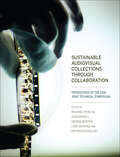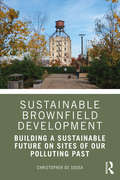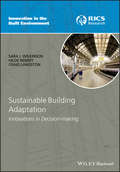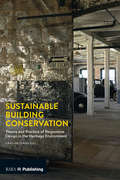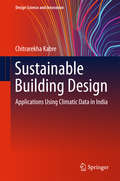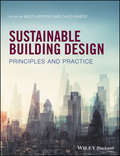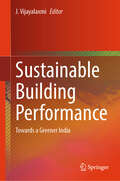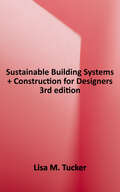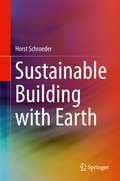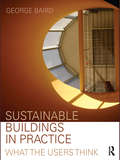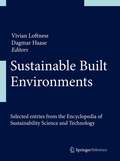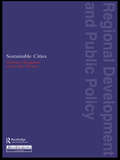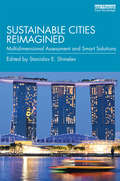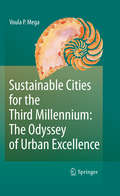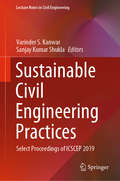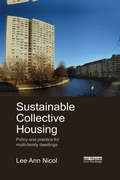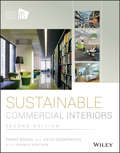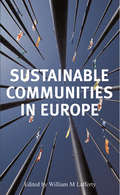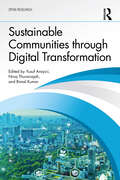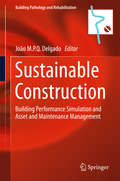- Table View
- List View
Sustainable Architectures: Critical Explorations of Green Building Practice in Europe and North America
by Steven A. Moore Simon GuyAs buildings are responsible for fifty per cent of CO2 emissions, their design has become the focus of intense technical scrutiny. Knowing how to build more technically efficient, or ecologically responsible, buildings, and being able to assemble the social resources to do so, requires different forms of knowledge and practice. There is wide contestation over the optimal pathways to greener buildings design and great diversity in practices of sustainable architecture.This volume brings together leading researchers from across the European Union and North America both to illustrate the diversity of practice and to provide a critical commentary on this key debate. The reader is provided with an introduction to competing perspectives on the sustainable architecture debate, international exemplars of differing practice and an overview of new theoretical and methodological resources for understanding and meeting the conceptual, social and technical challenges of sustainable architecture.
Sustainable Audiovisual Collections Through Collaboration: Proceedings of the 2016 Joint Technical Symposium
by Rachael Stoeltje Vicki Shively George Boston Lars Gaustad Dietrich SchüllerThe art and science of audiovisual preservation and access has evolved at breakneck speed in the digital age. The Joint Technical Symposium (JTS) is organized by the Coordinating Council of Audiovisual Archives Associations and brings experts from around the world to learn of technologies and developments in the technical issues affecting the long-term survival and accessibility of audiovisual collections. This collection of essays is derived from presentations made at the 2016 JTS held in Singapore and presents an overview of the latest audiovisual preservation methods and techniques, archival best practices in media storage, as well as analog-to-digital conversion challenges and their solutions.
Sustainable Brownfield Development: Building a Sustainable Future on Sites of our Polluting Past
by Christopher De SousaWhile industrial and chemical innovations have contributed extensively to human advancement, the darker part of their legacy has been the hundreds of thousands of polluted sites left behind. Governments at all levels have rallied to support the remediation and reuse of these land resources and put many of the nation’s brownfields back into productive use. This book presents two dozen brownfield projects in the United States that have incorporated sustainability, highlighting project features, best management practices, and lessons from the field regarding the underlying policies and practices that enabled these projects to be completed or, in some cases, stalled, altered or abandoned. The case studies represent an array of brownfield projects that aimed to go beyond conventional practice and include a range and variety of end uses (e.g., corner gas stations, industrial, office, residential, brightfields, green space, mixed-use and transit-oriented developments). The cases investigate site histories, planning and development and examine sustainability characteristics to understand how projects overcame the barriers to brownfield reuse and the implementation of sustainability features and derive a series of lessons learned, including innovative policies, programs, and/or funding mechanisms that helped make these projects work. Sustainable Brownfield Development will be of interest to developers, planners, consultants and community representatives interested in environmental policy, urban planning, community development, ecological restoration, economic development, and parks planning by providing direction and inspiration for those eager to erase the blight of the past and build a more sustainable future.
Sustainable Building Adaptation: Innovations in Decision-making (Innovation in the Built Environment)
by Sara J. Wilkinson Hilde Remøy Craig LangstonHow to adapt existing building stock is a problem being addressed by local and state governments worldwide. In most developed countries we now spend more on building adaptation than on new construction and there is an urgent need for greater knowledge and awareness of what happens to commercial buildings over time. Sustainable Building Adaptation: innovations in decision-making is a significant contribution to understanding best practice in sustainable adaptations to existing commercial buildings by offering new knowledge-based theoretical and practical insights. Models used are grounded in results of case studies conducted within three collaborative construction project team settings in Australia and the Netherlands, and exemplars are drawn from the Americas, Asia, Japan, Korea and Europe to demonstrate the application of the knowledge more broadly. Results clearly demonstrate that the new models can assist with informed decision-making in adaptation that challenges some of the prevailing solutions based on empirical approaches and which do not accommodate the sustainability dimension. The emphasis is on demonstrating how the new knowledge can be applied by practitioners to deliver professionally relevant outcomes. The book offers guidance towards a balanced approach that incorporates sustainable and optimal approaches for effective management of sustainable adaptation of existing commercial buildings.
Sustainable Building Conservation: Theory and Practice of Responsive Design in the Heritage Environment
by Oriel PrizemanThis book incorporates UK and international case studies and essays to identify the overlaps in the interests of energy and building conservation. The relevance and adjustments of qualitative and quantitative frames of reference are introduced, alongside the various expertise of the contributors: architects, designers, conservation consultants and academics. The second part of the book showcases sustainable domestic and non-domestic heritage projects, translating the preceding research into information that practitioners can use in their everyday work. The book will appeal to architecture students, newly qualified professionals and conservation architects and will enhance readers’ ambitions, so that they feel equipped and inspired to work with old buildings sensitively, creatively and sustainably.
Sustainable Building Design
by Chitrarekha KabreThis book bridges the gap between research and practice in the area of sustainable design of buildings, exploring the passive (climate-responsive) design and thermal behavior of buildings and ways to incorporate these enhancements in architectural and civil engineering practice. It presents climatic data and its analysis in a readily usable form and shows ways in which such data can be used to achieve passive (climate-responsive) and sustainable building design. The book presents case studies of sustainable building in each of five climatic zones of India. The book includes climatic data from 62 cities in India and describes how it can be synthesized in sustainable building design. The book can serve as a practical tool or handbook for architects, engineers, and designers, providing them with an understanding of the physical phenomena involved and a means for suitably implementing and applying passive (climate-responsive) design principles. It also offers a valuable resource for researchers, students, and policymakers working in the area of sustainable building design and construction.
Sustainable Building Design: Learning from nineteenth-century innovations
by Vidar LerumA twenty-first century renaissance is emerging in architecture. After a century of building designs characterized by high energy demand, low quality lighting and poor thermal comfort, the fundamental questions must be asked again: is there a better path to designing the most energy efficient, comfortable, functional and beautiful buildings for a sustainable future? While seeking solutions for the future, are there lessons to be learned from the best buildings of the past? Sustainable Building Design explores outstanding buildings and building designs of the twenty-first century, with an emphasis on the artistry of masters of architecture who came before. By dissecting and analyzing great public buildings of the nineteenth and twenty-first centuries, materials, techniques, and methods are discovered. This book presents the reader with clues and suggestions that will reveal the secrets of these buildings and by doing so provides the reader with a thorough understanding of how these architectural masterpieces work. Using photographs, drawings, sections, plans and diagrams which are painstakingly redrawn for consistency and clarity based on a wide range of documentation, Vidar Lerum compares works of architecture from the nineteenth and twenty-first centuries. The reader is presented with a careful analysis of each building, providing a compelling sourcebook of ideas for students and professional architects alike.
Sustainable Building Design: Principles and Practice
by Miles Keeping David ShiersAn inside view of how one of the world's leading architecture and engineering practice does business Sustainable Built Environments: Principles and Practice offers detailed, environmentally sound design solutions to a wide range of building engineering challenges. The text uses case examples and project data provided by engineers and designers at Arup Associates. It covers a broad range of relevant issues, with focused commentaries and explanations presented in an accessible format for use by students, busy practitioners and informed clients. Whilst this book stresses the importance of a unified approach to design, the text is divided into six principal chapters, each addressing an important aspect of sustainable architecture and engineering. These chapters (Master Planning, Transport, Energy, The Building Envelope, Environmental Services, and Materials) may be read on their own or in sequence as part of a narrative. Throughout the book, photographs, architectural and engineering drawings and diagrams, examples, and other data illustrate the case studies. Numerous web links are provided to additional information. This inspirational book: Focuses on the work of Arup Associates, the award winning architectural and engineering practice Uses real-life examples of functioning buildings and structures to provide information and guidance on the development of sustainable solutions Is packed with informative illustrations Sustainable Built Environments: Principles and Practice is a unique text that will inform and inspire architects and engineers, as well as students of those disciplines, around the globe.
Sustainable Building Performance: Towards a Greener India
by J. VijayalaxmiThis book highlights the evaluation and assessment of various aspects of sustainable buildings to achieve a greener future. India, at the 26th session of the United Nations Framework Convention on Climate Change (COP 26) in November 2021, announced its target to achieve net zero by 2070. Being an emerging economy, the number of buildings required is expected to grow exponentially. Hence, there is a need for a pragmatic and realistic path to reach the committed goal of reaching net zero. To participate in a global transition to clean, low-carbon energy systems, which aligns with Sustainable Development Goal (SDG) 11 (Sustainable Cities and Communities) and Climate Action (SDG 13), it is important to research cooling strategies for a tropical country like India. The India Cooling Action Plan clearly acknowledges the deep connection between SDGs, especially SDG 13. Passive cooling strategies require a micro-level understanding of the impact of building materials on the thermal performance of buildings. To contribute to the global transition to clean, low-carbon energy systems, it is essential to assess India's energy retrofit policies, the use of low-carbon building materials, energy-efficient building design to enhance passive cooling, ways to mitigate outdoor heat, and learnings from vernacular architecture and biophilic building design. This book explores how viable solutions such as these could address some of India's most pressing challenges, including energy efficiency, climate resilience, and environmental sustainability, contributing to India's progress towards SDG 3 (Good Health and Well-being), SDG 7 (Affordable and Clean Energy), SDG 9 (Industry, Innovation, and Infrastructure), and SDG 13. The research papers presented in this book are the result of systematic research conducted after identifying a research gap through the latest review of literature. They present new knowledge that can aid in making performance-based design decisions. All these aspects are analyzed using real-time data obtained through field studies. The book is a valuable resource for professionals and researchers working in energy efficiency and sustainable buildings.
Sustainable Building Systems and Construction for Designers: Bundle Book + Studio Access Card, Third edition
by Lisa M. TuckerAuthor Lisa M. Tucker covers topics in a holistic approach, from the structural (site consideration and foundations) to the experiential (indoor air, acoustics, and safety), making a clear case for interior design professionals to understand their moral responsibilities to people and the environment, and to follow sustainable building practices. Now in its third edition, the award-winning Sustainable Building Systems and Construction for Designers has been updated to reflect current CIDA accreditation standards and include recent industry trends related to interior construction, such as security and well-being. Additionally, a complete set of new case studies has been commissioned. Line drawings, color photography, and sample student work join together to support student learning on this essential and timely topic. New to this Edition: -Updated with CIDA Standards 2018 -Expanded content on security, resilience, plumbing, and well-being design trends -Complete set of 7 new case studies -First edition to include STUDIO with self-assessment questions and flashcards and Instructor Resources including an instructor's guide and PowerPoint slides
Sustainable Building for a Cleaner Environment: Selected Papers from the World Renewable Energy Network's Med Green Forum 2017 (Innovative Renewable Energy)
by Ali SayighThis book contains selected papers presented during the bi-annual World Renewable Energy Network’s Med Green Forum aimed at the international community as well as Mediterranean countries. This forum highlights the importance of growing renewable energy applications in two main sectors: Electricity Generation and the Sustainable Building Sector. In-depth chapters highlight the most current research and technological breakthroughs, covering a broad range of renewable energy technologies and applications in all sectors – for electricity production, heating and cooling, agricultural applications, water desalination, industrial applications and for the transport sectors.
Sustainable Building with Earth
by Horst SchroederThis book provides an insightful overview of the current state of earth building. The author approaches the subject from the perspective of the building material's life cycle, featuring in-depth explanations of the cycle's individual steps: extraction and classification of construction soil; production of earth building materials and earthen structures; planning, construction and renovation of earth buildings; and demolition and recycling of earthen structures. This unique resource provides examples of sophisticated earth building projects and illustrates the diverse applications of earth as a building material. Compared to conventional mineral building materials, earth possesses particularly positive ecological qualities such as its energy balance and recyclability. Architects, engineers, students, manufacturers and distributors of building materials, building contractors, building biologists, public authorities and preservationists will benefit from this book's ample coverage of restoring, optimizing and building with this material of the past, present and future.
Sustainable Buildings from Marble Waste Heaps: A New Methodology for Landscape Regeneration and Reuse
by Katia TalentoThis book examines how discarded marble heaps can be repurposed, in situ, to breathe new life into the landscape, offering solutions that are as innovative as they are practical and sustainable. The author showcases the power of creativity and sustainability to revitalize communities and landscapes with new architectural buildings and public spaces. The volume combines theory with practice, including an extensive bibliography about landscape mutation, rehabilitation of quarries and waste reuse, and, at the same time, a detailed case study on the Estremoz Anticline, in Portugal, one of the world’s main sites of marble extraction. Of all the material extracted from the several quarries of the Estremoz Anticline, only about 9% is marketed because of assessed of quality standards. Distinct from other research volumes in this domain, “Sustainable Buildings from Marble Waste Heaps” focuses on the regeneration of industrial landscapes through the on-site reuse of waste heaps, without removing the material from the context it belongs to or changing its morphology, preserving the identity of the place and promoting circular economy.
Sustainable Buildings in Practice: What the Users Think
by George BairdCurrent assessment methods of sustainable buildings do not adequately account for the users’ needs. Given that over the life of a building, total salary costs far outweigh both operating costs and combined capital and rental costs, the occupants’ needs are not something which should be sensibly ignored. This book presents an unbiased evaluation of thirty of the most cutting-edge, sustainable buildings in the world, in terms of the users’ perceived comfort, health and productivity. The author has visited the buildings, interviewed the design teams and examined the findings of a sixty-question standardized user questionnaire. The book provides: thirty case studies covering mixed-mode, passive and environmentally sustainable commercial and institutional buildings detailed insights into the principles underlying the design of sustainable buildings worldwide, over several climatic zones and eleven countries, together with clear explanations and illustrations of innovative design practice a discussion of common issues and the lessons that may be learnt from a study of the performance of sustainable buildings in practice, from the point of view of the people who use them. This important book will be of great benefit to architects and engineers, facility managers of commercial and institutional buildings, as well as developers and researchers, academics and students in these fields.
Sustainable Built Environments
by Vivian Loftness Dagmar HaaseSustainable design is a collective process whereby the built environment achieves unprecedented levels of ecological balance through new and retrofit construction, with the goal of long-term viability and humanization of architecture. Focusing on the environmental context, sustainable design merges the natural, minimum resource conditioning solutions of the past (daylight, solar heat, and natural ventilation) with the innovative technologies of the present. The desired result is an integrated "intelligent" system that supports individual control with expert negotiation for resource consciousness. International experts in the field address the fundamental questions of sustainable design and landscape management: How should the sustainability of landscapes and buildings be evaluated? Which targets have to be set and which thresholds should not be exceeded? What forms of planning and governance structures exist and to what extent do they further the goals of sustainability? Gathering 30 peer-reviewed entries from the Encyclopedia of Sustainability Science and Technology, Sustainable Built Environments provides comprehensive, multidisciplinary coverage of these issues and other aspects of sustainable building and landscape design.
Sustainable Cities (Regions and Cities #No.7)
by Graham Haughton Colin HunterSustainable Cities simultaneously tackles two issues of immediate public concern which also find themselves high on the policy agenda: sustainable environmental development and urban development. The themes of the book - the bringing together of the insights of environmental science, the social sciences and management; the combination of problem analysis with practical application; and a critique of urban environmental problems concentrating on air and water pollution - are illustrated throughout with in-depth material and case studies taken from around the world and are approached from a variety of perspectives: economic, ecological and managerial. Each chapter has a concluding section pointing to key concepts, key reading and a range of discussion points.
Sustainable Cities Reimagined: Multidimensional Assessment and Smart Solutions
by Stanislav ShmelevTo assess urban sustainability performance, this book explores several clusters of cities, including megacities, cities of the Global South, European and North American cities, cities of the Middle East and North Africa, cities of Central and South East Asia, a city state of Singapore and a large group of global cities. It applies a multi-criteria approach using a panel of environmental, economic, social and smart indicators to assess progress and policies in global cities including London, New York, Hong Kong, San Francisco, Los Angeles, São Paolo, Rio de Janeiro, Buenos Aires, Paris, Berlin, Stockholm, Moscow, Beijing, Seoul, Singapore, Shanghai, Sydney, Tokyo and many others. Additional attention is given to the issues of climate change, poverty and smart dimensions, with renewable energy and the drivers of urban CO2 emissions playing the central role. This book is abundant with case studies considering strategies, policies and performance of the leading cities, including San Francisco, Stockholm and Seoul in greater depth, exploring how their successes can be used by other cities. The book identifies key linkages between different smart and sustainability dimensions as well as investment opportunities in cities with sustainability potential. This book will be of great interest to policy makers, city and regional authorities as well as scholars and students of urban planning and sustainable development aiming to facilitate a sustainability transition in our cities around the world.
Sustainable Cities for the Third Millennium: The Odyssey of Urban Excellence
by Voula P. MegaThis book offers a 360 degree view of the challenges facing cities at the dawn of the millennium in terms of growth, governance, institutions and infrastructures, environmental well-being, social integration, science, culture and the arts, urban renaissance and planning, local democracy and citizenship. One year afte the crisis that started in 2008, the book presents responses to overcome the crisis of values and engage in a sustainability path from European and world cities.
Sustainable Civil Engineering Practices: Select Proceedings of ICSCEP 2019 (Lecture Notes in Civil Engineering #72)
by Sanjay Kumar Shukla Varinder S. KanwarThis book comprises select proceedings of the International Conference on Sustainable Civil Engineering Practices (ICSCEP 2019). It covers several important aspects of sustainable civil engineering practices dealing with effective waste and material management, natural resources, industrial products, energy, food, transportation and shelter, while conserving and protecting the environmental quality and the natural resource base essential for future development. The book also discusses engineering solutions to sustainable development and green design issues. Special emphasis is given on qualitative guidelines for generation, treatment, handling, transport, disposal and recycling of wastes. The book is intended as a practice-oriented reference guide for researchers and practitioners, and will be useful for all working in sustainable civil engineering related fields.
Sustainable Collective Housing: Policy and Practice for Multi-family Dwellings
by Lee Ann NicolHousing stocks provide much more than just shelter. Energy suppliers, pension fund managers and public transit providers are but a few of the many stakeholders that have a regulated interest in the non-shelter goods and services offered by housing. Such stakeholders and their activities are traditionally addressed on a sectoral basis, yet regulations that are designed to apply to one often have unintended effects on another, effects that may produce negative pressure on the housing stock – and the wider built environment – in terms of sustainability. Sustainable Collective Housing presents a new and comprehensive approach to the study of the regulations pertaining to housing: the institutional regimes framework. By considering the housing stock as a resource, this framework enables the ensemble of public policies, property rights and contracts that govern all shelter and non-shelter uses of housing to be identified, analyzed and evaluated. Using examples from Switzerland, Germany and Spain, this book describes the regulatory conditions that must be in place before housing sustainability issues can be effectively tackled. The book will provide policy-makers, housing stock owners and other stakeholders with the knowledge and tools to make rational and legitimate decisions regarding housing sustainability.
Sustainable Commercial Interiors
by Penny Bonda Katie SosnowchikDiscover new approaches to green design and sustainable building with this comprehensive guide There's a substantial amount of information designers and architects need to understand about sustainability and commercial projects, especially as expectations for professionals in the industry become clearer. Luckily, the second edition of Sustainable Commercial Interiors has been revamped to serve as a comprehensive guide for anyone looking to understand the latest in green and sustainable design. Fully revised throughout, this resource now includes frameworks based on the new LEED v4 rating system, and provides fifteen brand-new case studies that document green design and building strategies for all types of projects. You'll find information on materials, furnishings, finishes, product standards, and certifications, all designed to keep you in the know and prepare you for future ventures in sustainable design. The ideal professional companion for interior designers, commercial builders and developers, architects, and interior design students, this guide is an all-in-one introduction to the most essential topics in the industry, such as global environmental issues, water and energy usage, and the tools of the trade, to name just a few. The book is illustrated with full color images throughout. Fully revised and updated to include information on the new LEED v4 rating system Discusses the past, present, and future of sustainable design Considers global environmental issues, such as waste, land use, and bio-inspired design Covers water and energy usage and sustainable materials Discover the benefits of green building and adopt new approaches to sustainable design. Sustainable Commercial Interiors is your go-to resource for navigating new expectations for responsible interior design.
Sustainable Communities in Europe
by William M LaffertyA presentation of detailed comparative research into the implementation in 11 European countries of Local Agenda 21 - the action plan for sustainable development at community level. Overviews of implementation in each country are accompanied by analysis of positive and negative changes, as well as a comparative analysis with high academic and policy relevance. Numerous practical examples are included of best cases and crucial barriers.
Sustainable Communities through Digital Transformation (Spon Research)
by Yusuf Arayici Niraj Thurairajah Bimal KumarThis book brings together cutting-edge exploratory research findings to show how a vision for sustainable communities can be enabled by digital transformation. It attempts to apply existing knowledge about digital transformation and sustainable communities and compare, interpret, diagnose, and evaluate a variety of digital solutions to ascertain their suitability for the delivery of a more sustainable built environment. Chapters examine a breadth of issues including how digital transformations could: Provide digital/physical working/living environments that anticipate emerging lifestyles Blend digital engagements into the physical engagements within the built environment Support business and social activity in physical and online venues Use advanced information and community-oriented technologies for efficient management of urban services Promote sustainability Express narratives that celebrate the experience of place and community Leverage transformation of educational systems Foster linkages between universities, and between universities and businesses Facilitate working relationships among small and large companies Foster new processes and arrangements for innovation in the built environment By comparing the key principles of digital transformation with those of sustainable communities, the contributors seek to justify or discount the applicability of digital change for achieving more sustainable communities. The research presented in this book is essential reading for architecture, urban planning, quantity surveying, building surveying, real estate, and construction management professionals and academics.
Sustainable Communities: Creating a Durable Local Economy (Earthscan Tools for Community Planning)
by Rhonda Phillips Bruce Seifer Ed AntczakWith a foreword written by Senator Bernie Sanders What is a durable economy? It is one that not only survives but thrives. How is it created, and what does it take to sustain over time? Sustainable Communities provides insight and answers to these questions. Citing Burlington, Vermont's remarkable rise to award-winning status, this book explores the balance of community planning, social enterprise development, energy and environment, food systems and cultural well-being. Aimed at policymakers, development practitioners, students, and citizens, this book describes which and how multiple influences facilitate the creation of a local, durable and truly sustainable economy. The authors hope to inspire others by sharing this story of what can be done in the name of community economic development.
Sustainable Construction
by João M. P. Q. DelgadoThis book presents acollection of recent research works that highlight best practice solutions,case studies and practical advice on the implementation of sustainableconstruction techniques. It includes a set of new developments in the field ofbuilding performance simulation, building sustainability assessment,sustainable management, asset and maintenance management and service-life prediction. Accordingly, the book will appeal to a broad readership of professionals,scientists, students, practitioners, lecturers and other interested parties.

